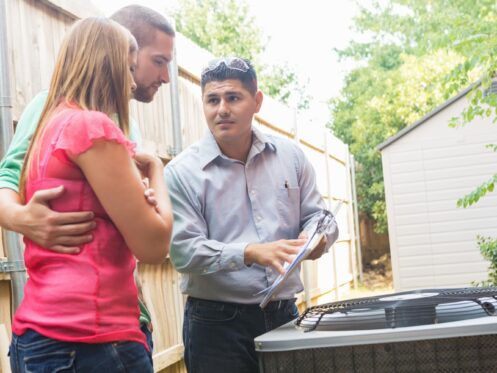Whether you’re building a home from scratch or think it’s time to replace your existing AC or heating equipment, you’ll have several types of HVAC systems to choose from. Each system has pros and cons you’ll need to weigh before deciding which one is right for you. You’ll also need to consider factors such as size and energy efficiency.
Ducted vs. Ductless Systems
Ducted HVAC systems include outdoor and indoor units connected by air ducts. The ducts are usually in ceilings and walls to ensure that air can circulate to every room of the home. The equipment outside the house is a condenser, while the indoor unit is an air handler. You can place your air handler in an area where you have extra space, such as a crawl space or attic.
Ductless systems also consist of condensers and indoor units. The units connect via a conduit that comprises suction tubing, refrigerant tubing, and a condensate drain. Depending on the type of ductless system you own, you can connect the condenser to one or more indoor units. Installers often mount the indoor part of the system to the ceiling or wall.
Ductless Mini-Splits
Ductless mini-split systems use a combination of indoor air handling units and condensers. This is the most common type of ductless system. The main advantage of a ductless mini-split is that it accommodates zoning. A mini-split can handle up to eight indoor units, so you should be able to maintain full coverage even without ducts.
These systems support cooling and heating. If you decide to buy wall-mounted indoor units for your home, look for ones that pair well with your interior design. Keep in mind that every indoor unit you obtain must have a dedicated electrical circuit.
Traditional Split System
Traditional split systems are often present in single-family homes. They usually come with multiple components to provide cooling and heating. If you use this setup in your home, you can control both components with a centralized thermostat. You can pair these systems with smart thermostats heat and cool the interior efficiently.
The components of a split system can be installed in numerous locations around your house. Consider placing the heating unit in a utility closet or basement. If you buy a traditional split system, you’ll need to have ductwork in place.
The heating unit will use a fan or evaporator to properly distribute heat through your home. The cooling unit will sit outside. When this system is running, a fan will take hot air outside, and refrigerant will cool the air that circulates inside.
Hybrid Split System
The main difference between hybrid split systems and traditional ones is that you don’t need to use gas. The heater can run on gas or electric power, depending on your preference. Most hybrid split systems come with a heat pump and gas furnace. Since gas heating is more powerful, the furnace will kick in when temperatures are at or below freezing. Heat pumps can deliver cooling and heating for milder temperatures.
Because of the level of flexibility available with a hybrid split system, you’ll have more control over your heating and cooling costs. If you purchase a system that comes with the ENERGY STAR label, you may also qualify for the Energy Efficient Home Improvement Credit. While the hybrid split system has many advantages, it might need more frequent maintenance.
Zoned HVAC System
A zoned HVAC system allows you to have more control over each area in your home. The ducts in these systems have special equipment that directs air to different zones as needed.
If you select this system, you’ll need a thermostat in each zone. For example, let’s say four people live in your home. Each household member can have control over their own zone and alter the temperature settings as they see fit.
You may be able to lower your energy bills with a zoned system by not heating or cooling areas you aren’t using. With a smart system, you can control the zones from an app on your smartphone.
Portable HVAC Systems
Two types of portable HVAC systems are available: heat pumps and spot coolers. You can use a portable heat pump to cool or heat your home. These systems come with reversing valves that make it possible to switch between the heating and cooling settings.
If you’re interested in spot coolers, they are designed to lower the temperature in large rooms, which is why they’re most often installed in commercial buildings. If you have a large living room or bedroom that suffers from inadequate cooling during the warm summer months, consider using a spot cooler.
These systems are designed to bring in ambient air, which then passes over a coil that refrigerant has cooled. The air can then be sent into the room. These systems generate condensation that can be collected in small tanks or pumped through a condensate line. If you use a system that has tanks, you may need to dispose of the condensate manually. Most spot coolers have wheels that allow you to move them to multiple locations with ease.
Window Units
Window HVAC systems are self-contained units. If you opt for this form of air conditioning in your home, you’ll need to use a different unit in each room or area that you want to cool. Even though these units are small and are designed to be fitted through windows or holes in exterior walls, they contain all the components that you’ll need to cool a room on a hot day.
The main advantage of using window units is that they’re affordable. They’re also portable and don’t require a comprehensive installation process. However, you’ll need to consider the aesthetics before choosing this option. Window units can also block natural light from entering your home.
Hydroponic Heating
Hydroponic heating is designed to increase a home’s interior temperature with liquid instead of air. These systems pair with boilers that heat the water before it makes its way throughout the rest of the home.
To benefit from this type of heating, you’ll need to have pipes installed under your floor. The liquid will travel through these pipes until it reaches a baseboard heater or radiator. The boiler can run on wood, gas, oil, or electricity. Since you don’t need to pair your hydroponic system with ducts, you should benefit from having a more efficient HVAC system.
Do you know what type of HVAC system you want for your home? Our technicians at Loves Air offer comprehensive HVAC installation services for residents of Modesto, CA and the surrounding area. If you’re unsure about buying a new system, we can help you determine if that’s the best option for you.
Our heating and cooling services team is knowledgeable about every type of HVAC system, from ductless mini-splits to window units. The HVAC offerings we provide also include repair and maintenance services. Call Loves Air today if you’d like to schedule our installation services for your new HVAC system.



